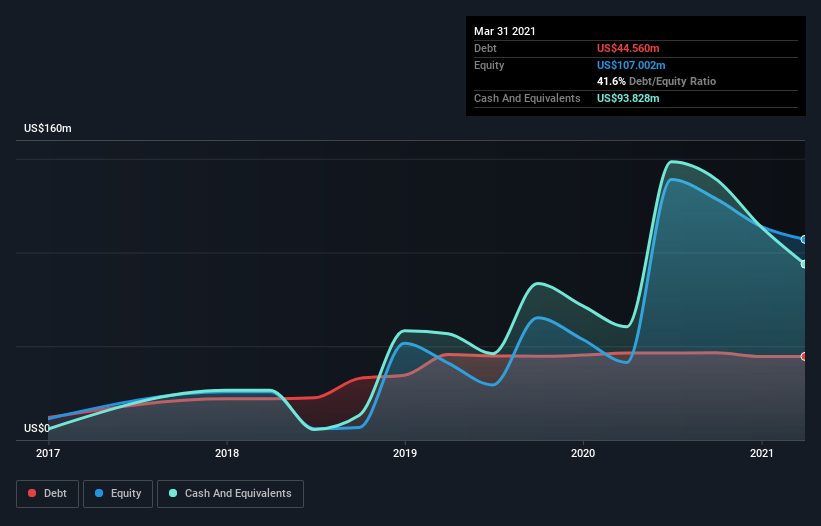Is Vapotherm (NYSE:VAPO) Weighed On By Its Debt Load?
The external fund manager backed by Berkshire Hathaway's Charlie Munger, Li Lu, makes no bones about it when he says 'The biggest investment risk is not the volatility of prices, but whether you will suffer a permanent loss of capital.' So it seems the smart money knows that debt - which is usually involved in bankruptcies - is a very important factor, when you assess how risky a company is. As with many other companies Vapotherm, Inc. (NYSE:VAPO) makes use of debt. But should shareholders be worried about its use of debt?
When Is Debt A Problem?
Debt and other liabilities become risky for a business when it cannot easily fulfill those obligations, either with free cash flow or by raising capital at an attractive price. Part and parcel of capitalism is the process of 'creative destruction' where failed businesses are mercilessly liquidated by their bankers. However, a more frequent (but still costly) occurrence is where a company must issue shares at bargain-basement prices, permanently diluting shareholders, just to shore up its balance sheet. Of course, plenty of companies use debt to fund growth, without any negative consequences. The first step when considering a company's debt levels is to consider its cash and debt together.
See our latest analysis for Vapotherm
How Much Debt Does Vapotherm Carry?
As you can see below, Vapotherm had US$36.2m of debt at March 2021, down from US$46.3m a year prior. But it also has US$93.8m in cash to offset that, meaning it has US$57.6m net cash.
A Look At Vapotherm's Liabilities
According to the last reported balance sheet, Vapotherm had liabilities of US$28.0m due within 12 months, and liabilities of US$56.0m due beyond 12 months. On the other hand, it had cash of US$93.8m and US$13.7m worth of receivables due within a year. So it actually has US$23.5m more liquid assets than total liabilities.
This short term liquidity is a sign that Vapotherm could probably pay off its debt with ease, as its balance sheet is far from stretched. Simply put, the fact that Vapotherm has more cash than debt is arguably a good indication that it can manage its debt safely. There's no doubt that we learn most about debt from the balance sheet. But ultimately the future profitability of the business will decide if Vapotherm can strengthen its balance sheet over time. So if you're focused on the future you can check out this free report showing analyst profit forecasts.
Over 12 months, Vapotherm reported revenue of US$139m, which is a gain of 153%, although it did not report any earnings before interest and tax. So its pretty obvious shareholders are hoping for more growth!
So How Risky Is Vapotherm?
Statistically speaking companies that lose money are riskier than those that make money. And the fact is that over the last twelve months Vapotherm lost money at the earnings before interest and tax (EBIT) line. And over the same period it saw negative free cash outflow of US$59m and booked a US$48m accounting loss. However, it has net cash of US$57.6m, so it has a bit of time before it will need more capital. The good news for shareholders is that Vapotherm has dazzling revenue growth, so there's a very good chance it can boost its free cash flow in the years to come. While unprofitable companies can be risky, they can also grow hard and fast in those pre-profit years. When analysing debt levels, the balance sheet is the obvious place to start. However, not all investment risk resides within the balance sheet - far from it. These risks can be hard to spot. Every company has them, and we've spotted 2 warning signs for Vapotherm you should know about.
When all is said and done, sometimes its easier to focus on companies that don't even need debt. Readers can access a list of growth stocks with zero net debt 100% free, right now.
This article by Simply Wall St is general in nature. It does not constitute a recommendation to buy or sell any stock, and does not take account of your objectives, or your financial situation. We aim to bring you long-term focused analysis driven by fundamental data. Note that our analysis may not factor in the latest price-sensitive company announcements or qualitative material. Simply Wall St has no position in any stocks mentioned.
Have feedback on this article? Concerned about the content? Get in touch with us directly. Alternatively, email editorial-team (at) simplywallst.com.

 Yahoo Finance
Yahoo Finance 
